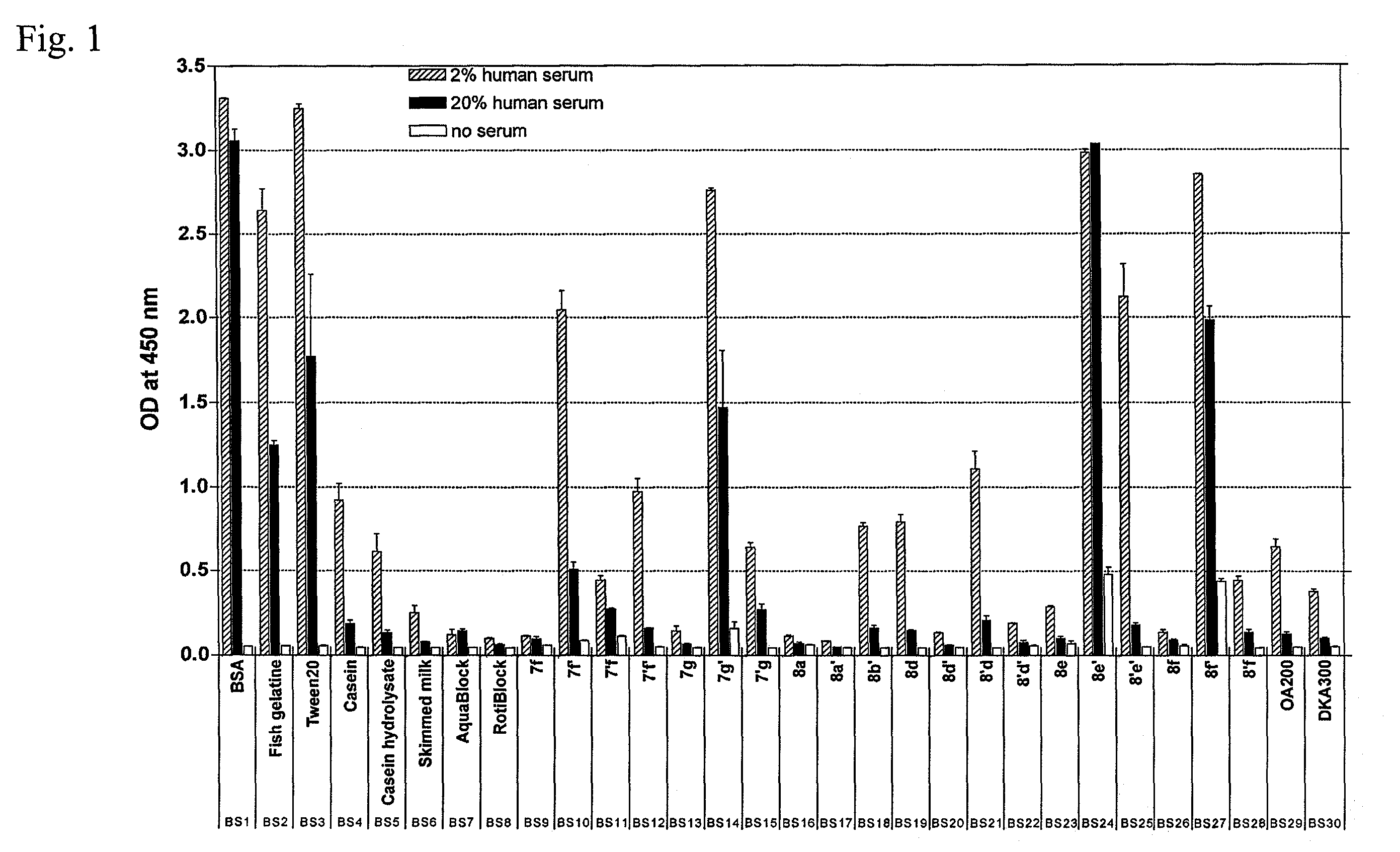Novel synthetic blocking reagents
a synthetic blocking and reagent technology, applied in the field of new synthetic blocking reagents, can solve the problems of reducing the signal-to-noise ratio, false-positive signals, and nsbs may disturb the recognition process between ligand and receptor
- Summary
- Abstract
- Description
- Claims
- Application Information
AI Technical Summary
Benefits of technology
Problems solved by technology
Method used
Image
Examples
example 1
Specificity-ELISA
[0126]This ELISA was designed to detect the degree of NSB of antibodies from human serum to polystyrene plates which had been pretreated with different blocking solutions. As such, high signals indicate high NSB, resulting from poor blocking ability of the blocking reagent and low signals indicate low NSB, as a result of efficient blocking.
[0127]Human serum was prepared from a freshly collected blood sample from a healthy adult blood donor (the sampling of blood for this purpose was approved by the Ethics Committee of the Medical University of Lübeck). 250 mL blood was drawn and incubated o / n at room temperature. The clotted blood was then incubated on ice for 1 h and centrifuged for 10 min at an rcf of 1,800×g. The supernatant was divided sterilely in 1.5 mL portions. The aliquots were snap-frozen in liquid nitrogen and stored at −80° C.
[0128]High-binding polystyrene microtiter plates were blocked with 150 μL / well of a specific blocking solution (BS1-30) for 7 h at...
example 2
Diagnostic ELISA 1—Prion Assay
[0130]This ELISA was designed to investigate the effect of different blocking reagents on the detection of prion protein (PrP) in reference samples. Low signals indicate a decreased sensitivity and vice versa.
[0131]For each blocking reagent six wells of high-binding polystyrene microtiter plates were coated o / n at 4° C. with 45 μL / well of a solution of a recombinant, His6-tagged prion protein fragment consisting of amino acids 90-231 of murine prion protein (PrP90-231) (Bade et al. (2006). Intranasal immunization of Balb / c mice against prion protein attenuates orally acquired transmissible spongiform encephalopathy. Vaccine 24:1242-1253), in a concentration of either 50 ng / mL or 3 ng / mL in L-PBS, or with L-PBS alone as a negative control o / n at 4° C. After washing the plates three times with 150 μL / well of PBST, the plates were blocked with 150 μL / well of a specific blocking solution (BS1-30) for 7 h at room temperature. The plates were washed four time...
example 3
Diagnostic ELISA 2—Hepatitis B Assay
[0133]In some cases it is important that a test yields a high sensitivity not only at certain concentrations of the biomolecules to be detected, but at a whole range of concentrations. Here, we determined the signal strength of a positive control of Hepatitis B surface antigen (HBsAg) in a serial dilution with a typical direct sandwich assay.
[0134]High-binding polystyrene microtiter plates were coated with 45 μL / well of 0.5 μg / mL goat anti-HBsAg (AbD Serotec, Kidlington, Oxford, UK) in D-PBS o / n at 4° C. After washing the plates four times with 150 μL / well of D-PBS, plates were blocked for 3 h at room temperature with 150 μL / well of a specific blocking solution (BS1-30). The plates were washed four times with 150 μL / well of D-PBS and incubated for 2 h at room temperature with 45 μL / well (serial dilution, 20,000, 8,000, 3,200, 1,280, 512, 205, 82, 33, 13, 5 ng / mL) of recombinant HBsAg (AbD Serotec, Kidlington, Oxford, UK) in the corresponding block...
PUM
| Property | Measurement | Unit |
|---|---|---|
| Mass | aaaaa | aaaaa |
| Mass | aaaaa | aaaaa |
| Mass | aaaaa | aaaaa |
Abstract
Description
Claims
Application Information
 Login to View More
Login to View More - R&D
- Intellectual Property
- Life Sciences
- Materials
- Tech Scout
- Unparalleled Data Quality
- Higher Quality Content
- 60% Fewer Hallucinations
Browse by: Latest US Patents, China's latest patents, Technical Efficacy Thesaurus, Application Domain, Technology Topic, Popular Technical Reports.
© 2025 PatSnap. All rights reserved.Legal|Privacy policy|Modern Slavery Act Transparency Statement|Sitemap|About US| Contact US: help@patsnap.com



